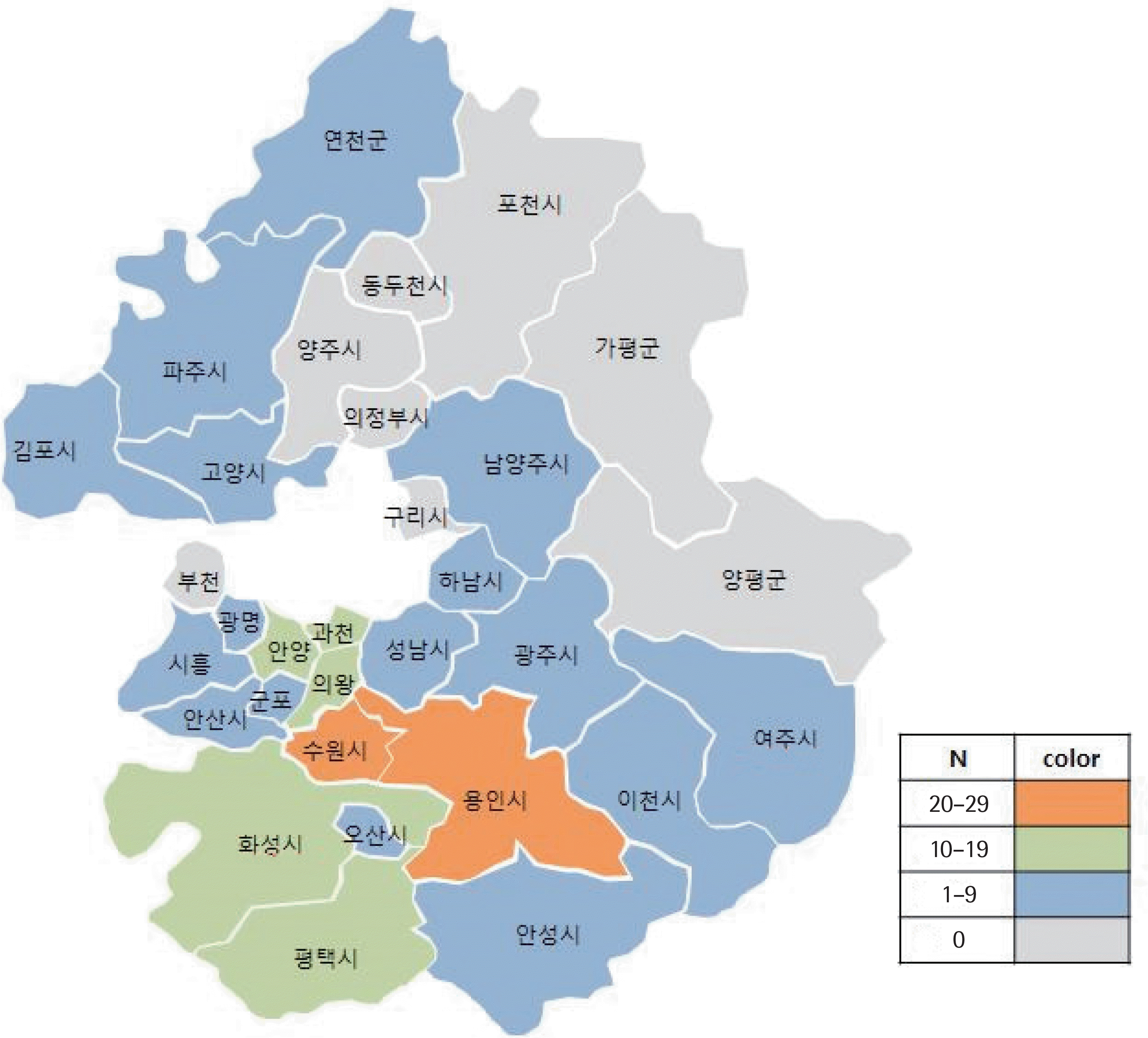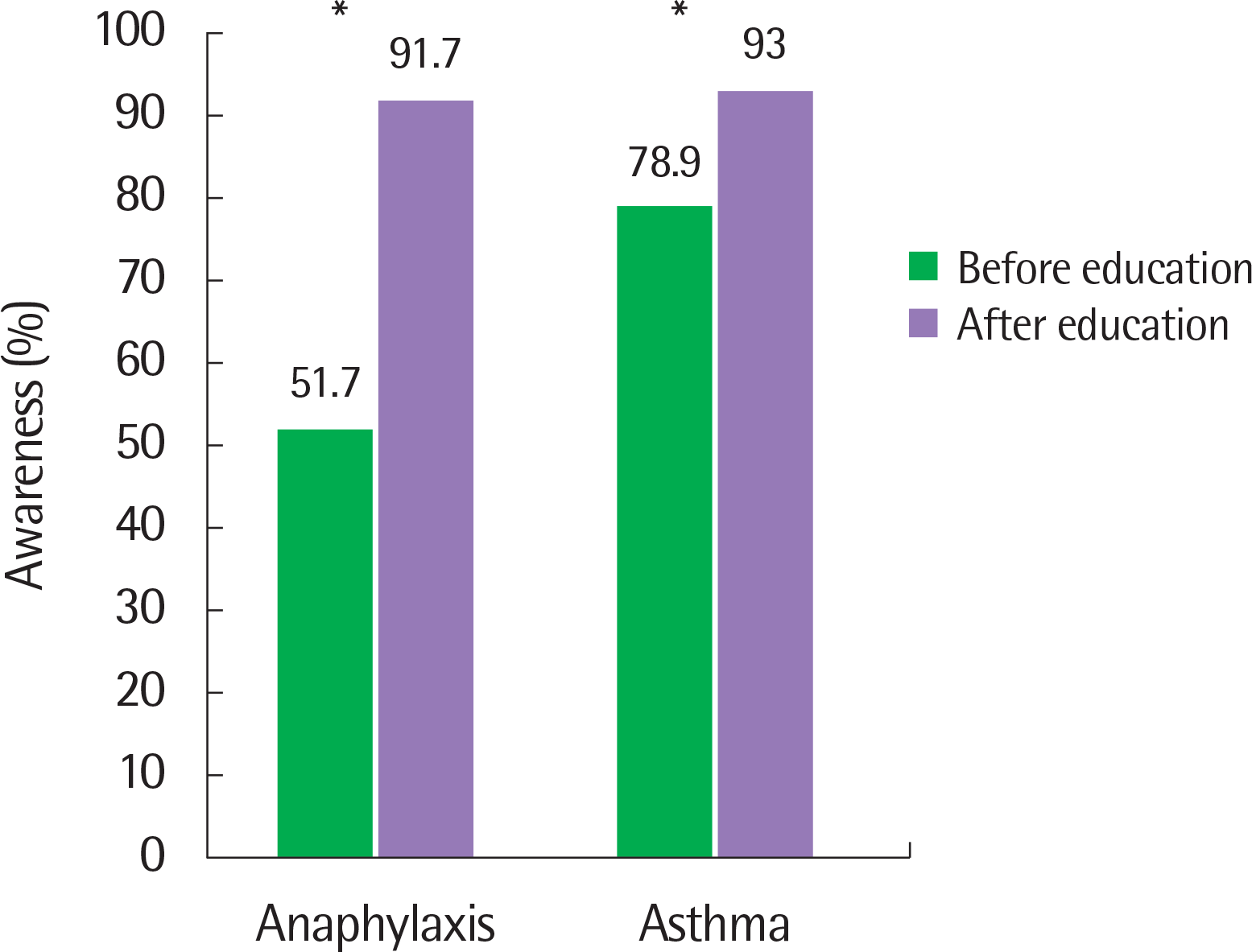Abstract
Purpose
Anaphylaxis and asthma exacerbation could be life-threatening medical emergencies. The 119 (911 in the United States) rescue teams are at the forefront of such emergency conditions. Early recognition and proper prehospital management by 119 rescuers are important. We evaluated the awareness of 119 rescuers of anaphylaxis and asthma exacerbation in Korea.
Methods
Between May 17 and June 28 of 2018, a total of 180 rescuers were recruited from Gyeonggi-do province, Korea. The 90-minute educational sessions on anaphylaxis and asthma exacerbation were provided by an allergy specialist, which included some lectures and a hands-on workshop on self-injectable epinephrine autoinjector. A questionnaire survey with the same content was performed before and after education to assess the improvement in awareness. It had 2 domains: anaphylaxis awareness and asthma awareness.
Results
After education, awareness score for anaphylaxis increased from an average of 3.1 (51.7%) to 5.5 (91.7%). Particularly, the effect of education on the use of epinephrine, the most crucial treatment for anaphylaxis, was greatest. The awareness score for asthma after education increased from an average of 21.3 (78.9%) to 25.1 (93%). The effect of education on treatment and management of asthma was greatest.
Go to : 
References
1. Simons FE, Ardusso LR, Bilò MB, El-Gamal YM, Ledford DK, Ring J, et al. World allergy organization guidelines for the assessment and management of anaphylaxis. World Allergy Organ J. 2011; 4:13–37.

2. Yang MS, Kim JY, Kim BK, Park HW, Cho SH, Min KU, et al. True rise in anaphylaxis incidence: epidemiologic study based on a national health insurance database. Medicine (Baltimore). 2017; 96:e5750.
3. Moneret-Vautrin DA, Morisset M, Flabbee J, Beaudouin E, Kanny G. Epidemiology of life-threatening and lethal anaphylaxis: a review. Allergy. 2005; 60:443–51.

4. Simons FE, Ardusso LR, Dimov V, Ebisawa M, El-Gamal YM, Lockey RF, et al. World Allergy Organization Anaphylaxis Guidelines: 2013 update of the evidence base. Int Arch Allergy Immunol. 2013; 162:193–204.

5. Braganza SC, Acworth JP, Mckinnon DR, Peake JE, Brown AF. Paediatric emergency department anaphylaxis: different patterns from adults. Arch Dis Child. 2006; 91:159–63.

6. Muraro A, Roberts G, Worm M, Bilò MB, Brockow K, Fernández Rivas M, et al. Anaphylaxis: guidelines from the European Academy of Allergy and Clinical Immunology. Allergy. 2014; 69:1026–45.

8. Jones C. Allergy UK, a national patient organisation, response to the BSACI guideline: prescribing an adrenaline autoinjector. Clin Exp Allergy. 2016; 46:1619–20.

9. Murad A, Katelaris CH. Anaphylaxis audit in a busy metropolitan Emergency Department: a review of real life management compared to best practice. Asia Pac Allergy. 2016; 6:29–34.

10. Kim MY, Park CS, Jeong JW. Management and educational status of adult anaphylaxis patients at emergency department. Korean J Intern Med. 2018; 33:1008–15.

12. Korean Academy of Asthma, Allergy, and Clinical Immunology, Korean Academy of Allergy and Respiratory Disease. Korean guideline for asthma [Internet]. Korean Academy of Asthma, Allergy, and Clinical Immunology, Korean Academy of Allergy and Respiratory Disease;c2019. [cited 2019 Feb 2]. Available from:. www.allergy.or.kr/file/150527_01.pdf.
13. Korean Statistical Information Service. Cause of death (236 items): number of death according to sex and age [Internet]. Sejong (Korea): Statistics Korea;c2019. [cited 2019 Feb 2]. Available from:. http://kosis.kr./statHt-ml/statHtml.do?orgId=101&tblId=DT_1B34E07&vw_cd=MT_ZTI-TLE&list_id=D11&seqNo=&lang_mode=ko&language=kor&obj_var_id=&itm_id=&conn_path=MT_ZTITLE.
14. Abramson MJ, Bailey MJ, Couper FJ, Driver JS, Drummer OH, Forbes AB, et al. Are asthma medications and management related to deaths from asthma? Am J Respir Crit Care Med. 2001; 163:12–8.

15. Simpson AJ, Matusiewicz SP, Brown PH, McCall IA, Innes JA, Greening AP, et al. Emergency prehospital management of patients admitted with acute asthma. Thorax. 2000; 55:97–101.

16. Yoo JH, Eo EK, Kim YJ, Song HS. Educational effect on prehospital personnel for prehospital stroke management. J Korean Soc Emerg Med. 2002; 13:23–30.
17. Marino MC, Ostermayer DG, Mondragon JA, Camp EA, Keating EM, Fornage LB, et al. Improving prehospital protocol adherence using bun-dled educational interventions. Prehosp Emerg Care. 2018; 22:361–9.

18. Turner PJ, Jerschow E, Umasunthar T, Lin R, Campbell DE, Boyle RJ. Fatal anaphylaxis: mortality rate and risk factors. J Allergy Clin Immunol Pract. 2017; 5:1169–78.

19. Brain death after eating curry provided as school meal…‘anaphylactic shock' [Internet]. JoongAng Ilbo;c2019. [cited 2019 Feb 2]. Available from:. https://news.joins.com/article/13772967.
20. Park SW, Lee BK, Yun SW. Necessity of epinephrine in prehospital stage – in the early management of anaphylaxis following a bee sting. J Korean Soc Emerg Med. 2012; 23:578–83.
21. Campbell RL, Bellolio MF, Knutson BD, Bellamkonda VR, Fedko MG, Nestler DM, et al. Epinephrine in anaphylaxis: higher risk of cardiovascular complications and overdose after administration of intravenous bolus epinephrine compared with intramuscular epinephrine. J Allergy Clin Immunol Pract. 2015; 3:76–80.

22. Jang GC, Chang YS, Choi SH, Song WJ, Lee SY, Park HS, et al. Overview of anaphylaxis in Korea: diagnosis and management. Allergy Asthma Respir Dis. 2013; 1:181–96.

23. Global Initiative for Asthma (GINA). Global strategy for asthma management and prevention 2018 [Internet]. Global Initiative for Asthma (GINA);c2019. [cited 2019 Feb 2]. Available from:. https://ginasthma.org.
24. Park SY, Yoon DL, Kang BJ, Kim GH, Cho YS, Moon HB, et al. A case of brain death due to asthma exacerbation in a noncompliant patient with refractory asthma. Korean J Med. 2012; 83:411–5.

25. D'Amato G, Vitale C, Molino A, Stanziola A, Sanduzzi A, Vatrella A, et al. Asthma-related deaths. Multidiscip Respir Med. 2016; 11:37.
26. Emergency medical service act [Internet]. Seoul (Korea): Korea Ministry of Government Legislation;c2019. [cited 2019 Feb 2]. Available from:. http://www.law.go.kr.
27. American College of Surgeons Committee on Trauma; American College of Emergency Physicians; National Association of EMS Physicians; Pediatric Equipment Guidelines Committee-Emergency Medical Services for Children (EMSC) Partnership for Children Stakeholder Group; American Academy of Pediatrics. Policy statement–Equipment for am-bulances. Pediatrics. 2009; 124:e166–71.
Go to : 
 | Fig. 1.Distribution of the fire stations and 119 centers of 180 rescuers who participated in the study. |
 | Fig. 2.Improved awareness on anaphylaxis and asthma exacerbation after education among 119 rescue teams. * P<0.05. |
Table 1.
Demographic characteristics (n=180)
Table 2.
Number of correct answers for each item in the anaphylaxis questionnaire before and after education
Table 3.
Number of correct answerers for number 7 item in the anaphylaxis questionnaire before and after education
Table 4.
Average of correct answer scores for each item in the asthma questionnaire before and after education




 PDF
PDF ePub
ePub Citation
Citation Print
Print


 XML Download
XML Download